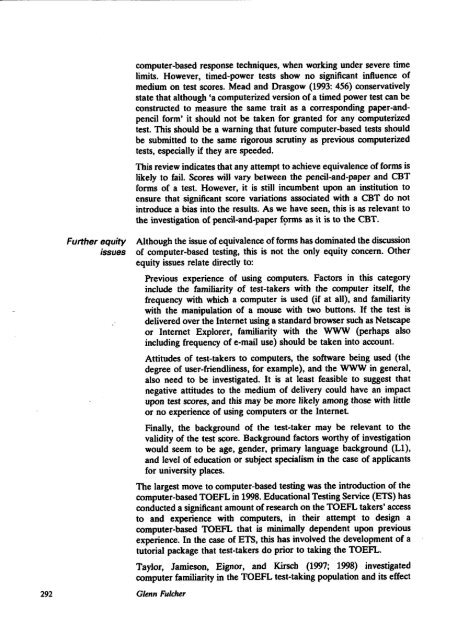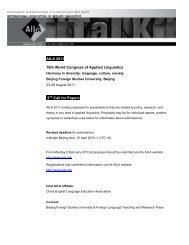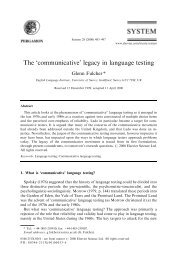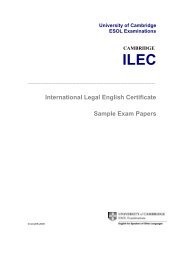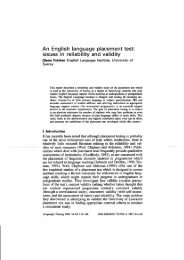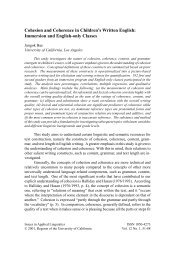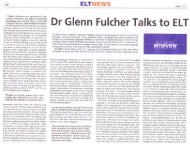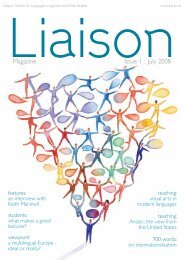Computerizing an English language placement test
Computerizing an English language placement test
Computerizing an English language placement test
Create successful ePaper yourself
Turn your PDF publications into a flip-book with our unique Google optimized e-Paper software.
292<br />
Further equQ<br />
issues<br />
computer-based respolrse techniques, when working under severe time<br />
limits. However, timed-power <strong>test</strong>s show no signific<strong>an</strong>t influence of<br />
medium on <strong>test</strong> scores. Mead <strong>an</strong>d Drasgow (1993: 456) conservatively<br />
state that although 'a computerized version of a timed power <strong>test</strong> c<strong>an</strong> be<br />
constructed to measure the same trait as a coresponding paper-<strong>an</strong>dpencil<br />
form' it should not be taken for gr<strong>an</strong>ted for <strong>an</strong>y computerized<br />
<strong>test</strong>. This should be a warning that future computer-based <strong>test</strong>s should<br />
be submitted to the same rigorous scrutiny as previous computerized<br />
<strong>test</strong>s, especially if they are speeded.<br />
This review indicates that <strong>an</strong>y attempt to achieve equivalence of forms is<br />
likely to fail. Scores will vary between the pencil-<strong>an</strong>d-paper <strong>an</strong>d CBT<br />
forms of a <strong>test</strong>. However, it is still incurnbent upon <strong>an</strong> institution to<br />
ensure that signific<strong>an</strong>t score variations associated with a CBT do not<br />
introduce a bias into the results. As we have seen, this is as relev<strong>an</strong>t to<br />
the investigation of pencil-<strong>an</strong>d-paper fgrms as it is to the CBT.<br />
Although the issue of equivalence of forms has dominated the discussion<br />
of computer-based <strong>test</strong>ing, this is not the only equity consern. Other<br />
equity issues relate directly to:<br />
Previous experience of using computers. Factors in this mtegory<br />
inctude the familiarity of <strong>test</strong>-takers with the cornputer itself, the<br />
frequency with which a computer is used (if at all), <strong>an</strong>d familiarity<br />
with the .m<strong>an</strong>ipulation of a mouse s'ith two buttons. If the <strong>test</strong> is<br />
delivered over the Internet using a st<strong>an</strong>dard browser such as Netscape<br />
or Internet Explorer, familiarity with the WWW (perhapa also<br />
including frequency of e-mail use) should be taken into ac@unt.<br />
Attitudes of <strong>test</strong>-takers to computers, the software being used (the<br />
degree of user-friendliness, for example), <strong>an</strong>d the WWW in general,<br />
also need to be investigated. It is at least feasible to suggest that<br />
negative attitudes to the medium of delivery could have <strong>an</strong> impact<br />
upon <strong>test</strong> scores, <strong>an</strong>d this may be more likely among those with little<br />
or no experience of using computers or the Internet.<br />
Finally, the background of the <strong>test</strong>-taker may be relev<strong>an</strong>t to the<br />
validity of the <strong>test</strong> s@re. Background factors worthy of investigation<br />
would seem to be og€, gender, primary l<strong>an</strong>guage background (L1),<br />
<strong>an</strong>d level of education or subject specialism in the case of applic<strong>an</strong>ts<br />
for university places.<br />
The largest move to cornputer-based <strong>test</strong>ing was the introduction of the<br />
computer-based TOEFL in 1998. Educational Testing Service (ETS) has<br />
conducted a signific<strong>an</strong>t amount of research on the TOEFL takers' access<br />
to <strong>an</strong>d experience with computers, in their attempt to design a<br />
computer-based TOEFL that is minimally dependent upon previous<br />
experience. In the case of ETS, this has involved the development of a<br />
tutorial package that <strong>test</strong>-takers do prior to taking the TOEFL.<br />
Taylor, Jamieson, Eigpor, <strong>an</strong>d Kirsch (1997; 1998) investigated<br />
computer familiarity in the TOEFL <strong>test</strong>-taking population <strong>an</strong>d its effect<br />
Glenn Fulclur


